early Industrial Revolution
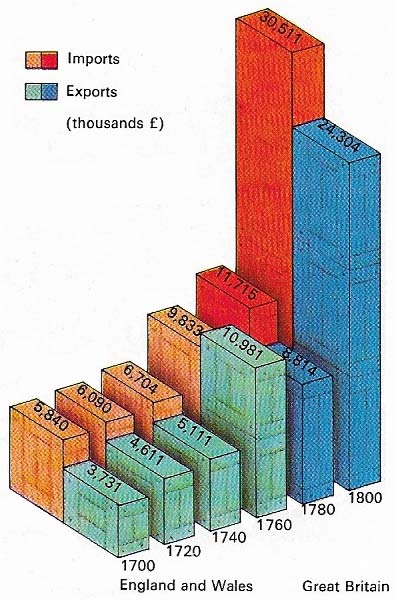
Figure 1. Industry was stimulated by growing demand, both at home and abroad. Britain's overseas trade experienced a rapid expansion from the 1600s, providing new market opportunities and the capital investment in new techniques. New colonial markets acquired after the Seven Years War proved lucrative, as Britain engaged in the 'Triangular Trade" carrying factory goods to Africa and the West Indies, transporting slaves across the Atlantic and bringing back colonial produce to Europe. Britain's largest export commodity in the first half of the 18th century was woollen textiles, but this was later overtaken by cotton.
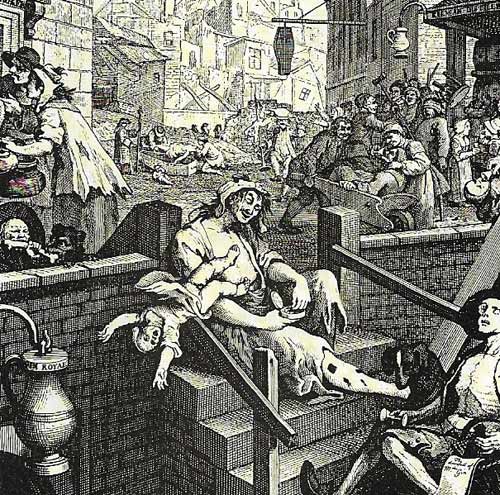
Figure 2. Europe's population increased from the 1750s, and despite some appalling conditions in towns (here shown at one extreme in one of William Hogarth's Gin Lane pictures), mortality rates declined. The cause of this is not fully understood but may have been related to the end of the plague epidemics after 1700 and improvements in hygiene after 1800, such as the availability of cheap soap, easily washable cotton clothing and improved water supply. Increased population because of earlier marriage and larger families provided a growing market for cheap industrial products and also necessary ready supply of labor.
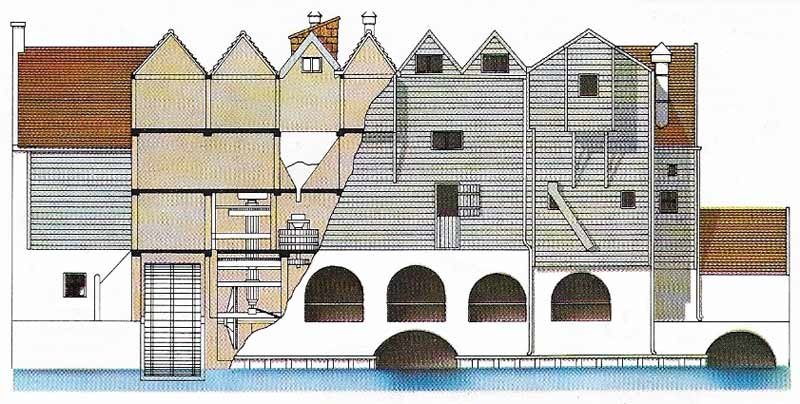
Figure 3. Mills driven by water provided motive force for many processes before the Industrial Revolution, including grinding corn and spinning yarn. A flourishing woollen industry already existed in areas where water power was readily available, such as the Cotswolds, East Anglia and the West Riding of Yorkshire. Many early machines could be driven by water power and the first phase of industrialization was based almost entirely upon the use of water-driven machinery. Both cotton and woollen industries developed on the slopes of the Pennines with abundant water power. It was only with the development of efficient steam power after 1776 that industry began to concentrate upon the coalfields and no longer had to depend on the hilly regions. The use of coal and invention of coke-smelting enabled industry to expand and escape the problems of a critical shortage of wood for fuel. However, the change to steam was gradual.

Figure 4. Agriculture could be highly profitable in the later 18th century thanks to a growing population and new techniques, as witness this substantial farmhouse in Gloucestershire. Enclosures grouped fields into more efficient units, permitting the use of four-crop and other rotations while selective breeding and inventions such as Jethro Tull's seed drill contributed to increased agricultural prosperity.

Figure 5. Transport developments played a vital part in the Industrial Revolution by widening markets and allowing production to be concentrated where goods could be brought by cheap bulk transport. Turnpikes and improved road surfaces increased passenger traffic by road, but the most important advance for industry came with the development of canals. The Bridgewater Canal between Worsley and Manchester was built for the Duke of Bridgewater by James Brindley (1716–1772), an engineer who remained illiterate until his death. The canal, opened in 1761, halved the cost of coal in Manchester by reducing transport costs. In the canal mania that followed, an extensive canal network was built up and many early industries were based on it, giving them access to raw materials and markets.

Figure 6. Josiah Wedgwood (1730–1795) pioneered the large-scale production of pottery at his Etruria works near Stoke-on-Trent. He was a self-educated man and typical of those who made the Industrial Revolution.
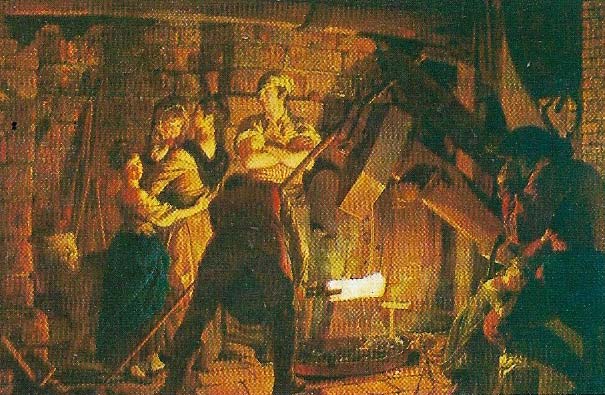
Figure 7. Labor conditions were often poor in the early stages of the Industrial Revolution. Child labor was common, especially in the textile industry, with long hours of work, low pay and frequent accidents. Women also worked in the textile factories, where they made up half the workforce. Though women and children had worked on the land, these new industrial conditions provoked a series of Parliamentary enquiries in Britain and by the mid-19th century Factory Acts were passed, restricting hours of work and prohibiting women and children from certain areas of employment, such as work underground. By 1900 most other industrialized nations also introduced some form of factory legislation.
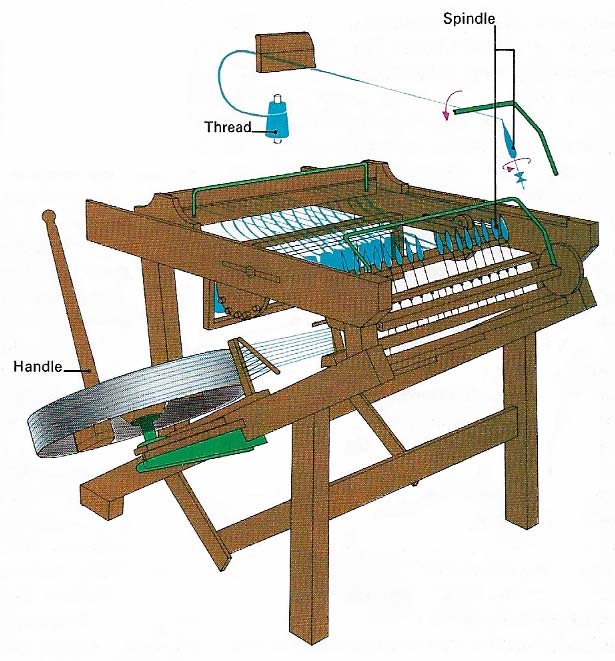
Figure 8. The use of machinery during this period greatly increased the production of goods. James Hargreaves's spinning Jenny (1764) increased output of spun cotton.
Britain was the first industrial nation in the world. From the middle of the eighteenth century, a number of factors launched Britain into a period of self-sustaining economic growth by the first decade of the 19th century. However, the origins of the Industrial Revolution in Britain lay in the pre-industrial period; by the middle of the eighteenth century there was already a thriving commercial economy, with a growing population, developing agriculture, and expanding trade both at home and abroad.
Population growth
The growth of Britain's population from the mid-18th century was not directly caused by industrialization although a large workforce was an essential factor in the development of industry. A run of good harvests in the first half of the century, low food prices, favorable climatic conditions, the decline of plague and a number of minor improvements in health all contributed to lower death rates and a consequent rise in population (Figure 2). By the end of the 18th century, birth-rates began to rise, too, as people in the industrial towns were able to marry earlier and to have, and keep, more children. Unlike Ireland, where population growth led to impoverishment and, ultimately, to famine, Britain's commercial and agricultural prosperity meant that a growing demand for products of every kind. Increased consumption was a stimulus to industrial innovation and methods production.
In the past, periods of agriculture expansion had been checked by harvest failure, population level and economic downturn. By the middle of he eighteenth century, the profits of thriving overseas trade enabled landowners to borrow capital to increase, agricultural production (Figure 4). With increasing demand and prices for foodstuffs, agricultural expansion followed. The enclosure movement propped the old open fields and common lands into individual, more efficient units, on which more productive techniques could be applied, such as improved animal husbandry, new root corps and the first agricultural machines. Enclosure, secured through Parliamentary Acts, had affected about 20 percent of the area of England by 1845. Capital was required to make the most of enclosure and it led to many smaller farms being amalgamated into larger holdings. Contrary to common myth, enclosure did not depopulate the countryside, but often increased the demand for agricultural labor.
Increased demand
The continued profitability of foreign trade (Figure 1), particularly as the colonies grew, provided the capitol for increases in production to meet demand at home and abroad. One of the first industries to feel this increased demand was mining, with the need for more domestic and industrial fuel. Output was increased 400 per cent in the course of the eighteenth century through the use of steam pumping engines to keep mines from flooding. Coal was an important raw material for many industrial processes as well as the fuel for steam power. Coal and iron together laid the foundations for the development of industry. The iron industry of the early eighteenth century depended on charcoal for smelting and had a relatively small output. The discovery by Abraham Darby of coke-smelting at his Coalbrookdale works in the 1730s revolutionized the production of cheap iron and enabled it to be used in the first machines and iron structures.
Allied to these developments, there was a major advance in technological power following the patenting of the improved Boulton and Watt steam engines after 1774. They used much less fuel than the earlier models. Beside pumping, Watt's steam engine of 1769 was harnessed to drive machinery.
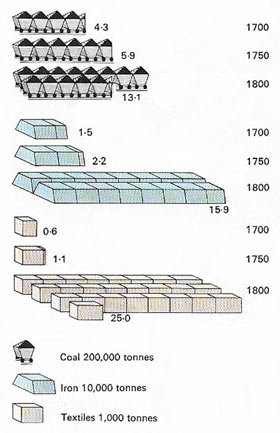 |
| The most striking developments in 18th century industry were shown in coal, textiles, and iron production. Coal mining expanded with the rise of steam power, a growing population and improvements in communications. Wool output increased to meet domestic and foreign demand, but mainly using traditional processes. Cotton production grew dramatically with the use of machinery and steam power until it became Britain's principal export commodity. Iron production also increased rapidly with the introduction of coke-smelting. These developments were evidence of a broad expansion of techniques to meet opportunities presented by rapidly growing markets. |
Labor-saving machinery
After steam power, the most important innovations were associated with the growth of labor-saving machinery. They occurred most dramatically in the cotton industry, which witnessed technical breakthroughs in weaving (Kay's flying shuttle, 1733) then in spinning and gradually in other processes. The harnessing of steam power to machinery in the cotton industry led to the first factories in which production processes were concentrated under one roof. Although many factories still relied on water power (Figure 3), the development of the factory system in cotton foreshadowed the growth of the factory and the use of steam in other industries. Woollen production, for example, expanded mainly by using traditional methods such as water power. Gradually, however, the introduction of machinery and the use of steam power drew it towards the coalfields of the West Riding of Yorkshire.
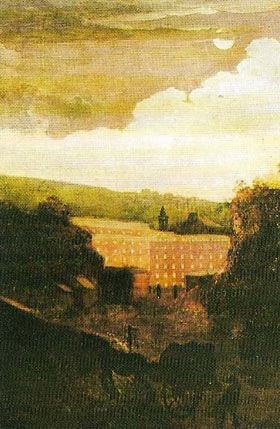 |
| A pioneer of the factory system, Sir Richard Arkwright (1732–1792) built this cotton mill at Cromford, Derbyshire, which Joseph Wright of Derby painted in the 1780s. The first factories were built for textile industry, where mechanization and the use first of water power, then of steam, made concentration of production essential. Factories increased in size as steam became the principal source of power. The words "factory" and "mill" were synonymous for a long while. |
Concentration of production needed both capital and cheap transport. Capital was provided out of the profits of agricultural improvement and overseas trade. Country banks, although subject to panics and bankruptcies, did provide a basic network of credit for industrial and agricultural development. By 1800 there were about 70 London banks and about 400 country banks, usually issuing their own notes. The Stock Exchange was founded in 1773.
Land transport remained slow and expensive for bulky products in spite of the development of turnpikes. River transport was cheaper, but it was only with the development of the canal network that bulky products could be moved cheaply.
